Sextans constellation lies in the southern sky, on the celestial equator. It represents the astronomical sextant.
Sextans is located in a dim region of the sky between the constellations Hydra, Crater, and Leo. The constellation was created by the Polish astronomer Johannes Hevelius in the 17th century. It is a rather faint one, with only one star brighter than fifth magnitude.
Sextans contains several notable deep sky objects, among them the Spindle Galaxy (NGC 3115), the spiral galaxies NGC 3166 and NGC 3169, and the irregular galaxies Sextans A and Sextans B. It is also home to the most distant known galaxy cluster, CL J1001+0220, and the Cosmos Redshift 7 galaxy, which contains stars formed soon after the Big Bang.
Facts, location and map
Sextans is the 47th constellation in size, occupying an area of 314 square degrees. It is one of the 15 equatorial constellations. It is located in the second quadrant of the southern hemisphere (SQ2) and can be seen at latitudes between +80° and -90°. The neighboring constellations are Crater, Hydra and Leo.
The constellation name Sextans is pronounced /ˈsɛkstənz/. In English, the constellation is known as the Sextant. The genitive form of Sextans, used in star names, is Sextantis (pronunciation: /sɛksˈtæntɪs/). The three-letter abbreviation, adopted by the International Astronomical Union (IAU) in 1922, is Sex.
Sextans does not have any stars brighter than magnitude 3.00 and contains five stars located within 10 parsecs (32.6 light years) of Earth.
The brightest star in the constellation is Alpha Sextantis, with an apparent magnitude of 4.49. The nearest star is the red dwarf LHS 292 (spectral class M6.5 V), located at a distance of only 14.8 light years from Earth.
Sextans has five stars with confirmed exoplanets, HD 86081 (spectral class F8V), HIP 49067 (K3V), WASP-43 (K7V), 24 Sextantis (G5III, two giant exoplanets), and HD 92788 (G5V). The planet orbiting WASP-43, discovered on April 15, 2011, was the most closely orbiting hot Jupiter ever found at the time of discovery. The two planets orbiting the star 24 Sextantis are in a 2:1 resonance, which means that the outer planet orbits the star once every time the inner planet completes two orbits.
Sextans belongs to the Hercules family of constellations, along with Aquila, Ara, Centaurus, Corona Australis, Corvus, Crater, Crux, Cygnus, Hercules, Hydra, Lupus, Lyra, Ophiuchus, Sagitta, Scutum, Serpens, Triangulum Australe and Vulpecula.
Sextans does not contain any Messier objects. There is one daytime meteor shower associated with the constellation, the Sextantids, occurring in late October and early November.
Sextans contains two formally named stars. The star names approved by the International Astronomical Union (IAU) are Bibhā (HD 86081) and Gnomon (WASP-43).
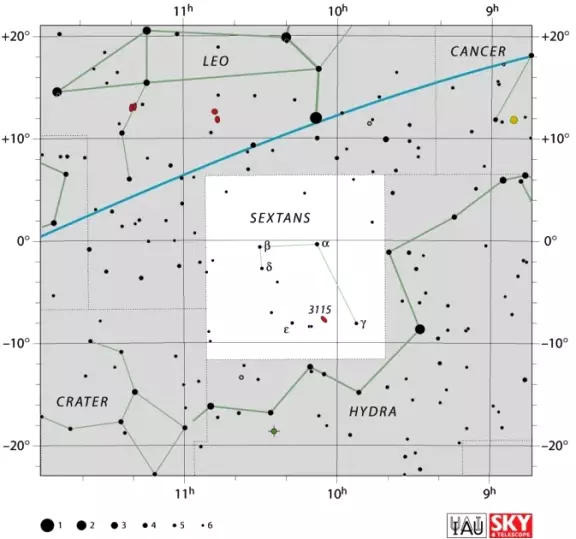
Sextans constellation map by IAU and Sky&Telescope magazine
Story
Sextans constellation is not associated with any myths. It was introduced by the Polish astronomer Johannes Hevelius in 1687. Hevelius originally named the constellation Sextans Uraniae after the instrument he had used to measure star positions until it was destroyed in a fire at his observatory in 1679.
Even though telescopes were available to him, Hevelius preferred to use the sextant for sightings, and continued to do so throughout his life.
Major stars in Sextans
α Sextantis (Alpha Sextantis)
Alpha Sextantis is a white giant star with the stellar classification A0III. It has an apparent magnitude of 4.48 and is approximately 287 light years distant from Earth. It is the brightest star in Sextans. It is 122 times more luminous than the Sun and has a mass three times solar. The star is believed to be about 300 million years old.
Alpha Sextantis is informally considered to be an “equator star,” currently located less than a quarter of a degree south of the celestial equator. In 1900, it was 7 arc minutes north of the equator, but crossed over to the southern hemisphere in December 1923. The star lies almost exactly south of the bright star Regulus in Leo constellation, and only 0.4 arc minutes to the west.
γ Sextantis (Gamma Sextantis)
Gamma Sextantis is a triple star system in Sextans constellation. It has an apparent magnitude of 5.07 and is approximately 262 light years distant.
The system consists of a close binary star with the stellar classification A1. The two stars are separated by 0.38 arc seconds and have visual magnitudes of 5.8 and 6.2. They orbit each other with a period of 77.6 years.
A 12th magnitude companion orbits the binary star from a distance of 36 arc seconds.
β Sextantis (Beta Sextantis)
Beta Sextantis is a blue-white main sequence dwarf with the stellar classification B6V. It has an apparent magnitude of 5.0 to 5.1 and is approximately 345 light years distant.
Beta Sextantis is classified as an Alpha-2 Canum Venaticorum type variable star. It has a period of variability of around 15.4 days.
δ Sextantis (Delta Sextantis)
Delta Sextantis is a blue-white main sequence dwarf with the stellar classification of B9.5V. It has an apparent magnitude of 5.19 and is approximately 300 light years distant from the solar system.
ε Sextantis (Epsilon Sextantis)
Epsilon Sextantis is a yellow-white giant star belonging to the stellar class F2 III. It has an apparent magnitude of 5.25 and is approximately 183 light years distant from the Sun.
24 Sextantis
24 Sextantis is a yellow subgiant star belonging to the stellar class G5 IV. It has an apparent magnitude of 6.61 and is approximately 253 light years distant. The star is believed to be about 2.8 billion years old. It has 54 percent more mass than the Sun.
Two giant extrasolar planets were discovered orbiting the star in July 2010. The inner planet has twice the mass of Jupiter and orbits the star every 453 days. The outer planet has 5/6 the mass of Jupiter and orbits the star every 883 days. The planets are in a 2:1 resonance: the outer planet orbits the star once every time the inner planet completes two orbits.
LHS 292
LHS 292 is a red dwarf star in Sextans. It has the stellar classification of M6.5 V. It has an apparent magnitude of 15.73 and is only 14.8 light years distant from Earth. In spite of its proximity, the star cannot be seen without at least a large amateur telescope.
LHS 292 is a flare star, and its brightness can suddenly increase over short periods of time.
HD 92788
HD 92788 is a class G5 star in Sextans. It has a visual magnitude of 4.72 and is 107.1 light years distant. It is slightly smaller than the Sun and more massive. An extrasolar planet was discovered orbiting the star in 2001. It has a mass at least 3.67 times that of Jupiter and it orbits the star every 325.81 days.
HD 86081
HD 86081 is a yellow-white main sequence dwarf star with the stellar classification of F8V. It has a visual magnitude of 8.74 and is approximately 297 light years distant from Earth. The star has a luminosity 1.75 solar. A planet with at least 1.50 times the mass of Jupiter orbits the star every 2.1375 days.
BD-08°2823
BD-08°2823 is an orange main sequence dwarf belonging to the stellar class K3V. It has an apparent magnitude of 9.86 and is approximately 137 light years distant from Earth. The star is smaller, less massive and cooler than the Sun.
Two gas giants were discovered orbiting the star in 2009. The inner planet completes an orbit every 5.60 days, and the outer one orbits the star every 237.6 days.
WASP-43
WASP-43 is an orange dwarf with the stellar classification of K7V. It has an apparent magnitude of 12.4. The star has about half the mass (58 percent) of the Sun and 0.598 times the radius. A planet, a Hot Jupiter, was discovered orbiting the star in April 2011. At the time, it was the most closely orbiting Hot Jupiter discovered.
The planet, WASP-43b, has 1.78 times the mass of Jupiter and 0.93 times Jupiter’s radius. It completes an orbit around the star every 0.813475 days.
Deep sky objects in Sextans
Spindle Galaxy – NGC 3115 (Caldwell 53)
The Spindle Galaxy is a lenticular galaxy in Sextans. It has an apparent magnitude of 9.9 and is approximately 31.6 million light years distant from Earth. The galaxy appears almost exactly edge-on. It is several times bigger than the Milky Way. It has a supermassive black hole at its centre.
NGC 3115 is the nearest galaxy with a billion-solar-mass black hole to Earth. The galaxy was discovered by William Herschel on February 22, 1787. Most of the stars in it are pretty old, and the galaxy does not have much dust and gas left for new star formation to take place.
NGC 3115 should not be confused with Messier 102 (NGC 5866) in Draco constellation, which is also called the Spindle Galaxy.
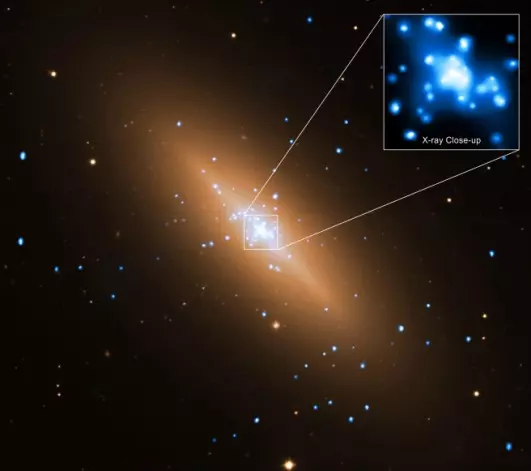
The galaxy NGC 3115 is shown here in a composite image of data from NASA’s Chandra X-ray Observatory and the European Southern Observatory’s Very Large Telescope (VLT). Using the Chandra image, the flow of hot gas toward the supermassive black hole in the center of this galaxy has been imaged. This is the first time that clear evidence for such a flow has been observed in any black hole. The Chandra data are shown in blue and the optical data from the VLT are colored gold. The point sources in the X-ray image are mostly binary stars containing gas that is being pulled from a star to a stellar-mass black hole or a neutron star. The inset features the central portion of the Chandra image, with the black hole located in the middle. No point source is seen at the position of the black hole, but instead a plateau of X-ray emission coming from both hot gas and the combined X-ray emission from unresolved binary stars is found. To detect the black hole’s effects, astronomers subtracted the X-ray signal from binary stars from that of the hot gas in the galaxy’s center. Then, by studying the hot gas at different distances from the black hole, astronomers observed a critical threshold: where the motion of gas first becomes dominated by the supermassive black hole’s gravity and falls inwards. The distance from the black hole where this occurs is known as the “Bondi radius.” As gas flows toward a black hole it becomes squeezed, making it hotter and brighter, a signature now confirmed by the X-ray observations. The researchers found the rise in gas temperature begins at about 700 light years from the black hole, giving the location of the Bondi radius. This suggests that the black hole in the center of NGC 3115 has a mass of about two billion times that of the Sun, supporting previous results from optical observations. This would make NGC 3115 the nearest billion-solar-mass black hole to Earth. NGC 3115 is located about 32 million light years from Earth and is classified as a so-called lenticular galaxy because it contains a disk and a central bulge of stars, but without a detectable spiral pattern. Image: X-ray: NASA, CXC, Univ. of Alabama, K. Wong et al; Optical: ESO, VLT
NGC 3169
NGC 3169 is a spiral galaxy in Sextans. It has an apparent magnitude of 10.3 and is approximately 70 million light years distant. It can be found just under the bright star Regulus in Leo constellation.
The galaxy has a distorted shape as a result of gravitational interaction with nearby galaxy NGC 3166. Both galaxies were discovered by William Herschel in 1783. A supernova, SN 2003cg, was discovered in NGC 3169 in 2003.
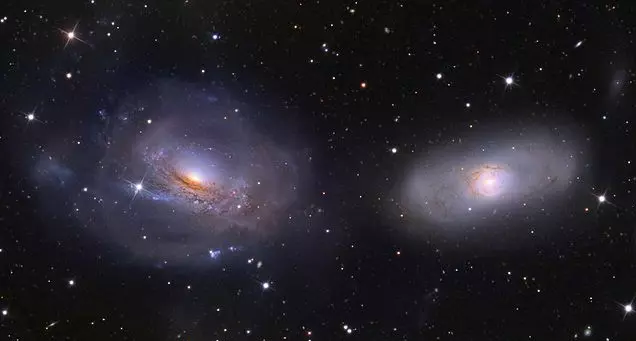
NGC 3169 and NGC 3166, image: Adam Block/Mount Lemmon SkyCenter/University of Arizona (CC BY-SA 3.0 US)
NGC 3166
NGC 3166 is also a spiral galaxy. It lies about 50,000 light years from NGC 3169. The two galaxies will eventually merge into one larger galaxy.
Sextans A (UGCA 205)
Sextans A is a small dwarf irregular galaxy in Sextans. It is only about 5,000 light years across. It has a visual magnitude of 11.9 and is approximately 4.31 million light years distant from Earth. The galaxy is located within the Local Group of galaxies.
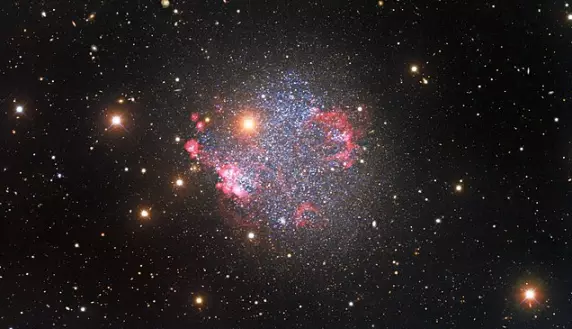
This glittering image captured by the Nicholas U. Mayall 4-meter Telescope at Kitt Peak National Observatory, a Program of NSF’s NOIRLab, shows the irregular dwarf galaxy Sextans A, which lies around 4.4 million light-years from Earth. This galaxy, which is only a fraction of the size of the Milky Way, has been contorted by successive waves of supernova events into the roughly square shape we see from Earth — a cosmic jewelry box filled with bright young stars. Sextans A is displayed in style in this gorgeous image, which showcases the irregular shape of this dwarf galaxy. Irregular galaxies such as Sextans A don’t have the regular appearance of spiral or elliptical galaxies, but instead display a range of weird and wonderful shapes. These galaxies are relatively small, and they are often susceptible to distortions resulting from close encounters or collisions with larger galaxies — sometimes leading to their irregular shapes. Sextans A is particularly small, measuring only about 5000 light-years across. Image: KPNO/NOIRLab/NSF/AURA Data obtained and processed by: P. Massey (Lowell Obs.), G. Jacoby, K. Olsen, & C. Smith (AURA/NSF); image processing: T.A. Rector (University of Alaska Anchorage/NSF’s NOIRLab), M. Zamani (NSF’s NOIRLab) & D. de Martin (NSF’s NOIRLab)
Sextans B (UGC 5373)
Sextans B is an irregular galaxy with an apparent magnitude of 11.9. It is approximately 4.44 million light years distant. The galaxy is located either within the Local Group or just beyond it.
Five planetary nebulae have been discovered in Sextans B. It is one of the smallest galaxies in which planetary nebulae have been found.
Sextans B forms a pair with its neighbour Sextans A. It might also be gravitationally associated with the galaxies NGC 3109 in Hydra constellation and the Antlia Dwarf in Antlia.
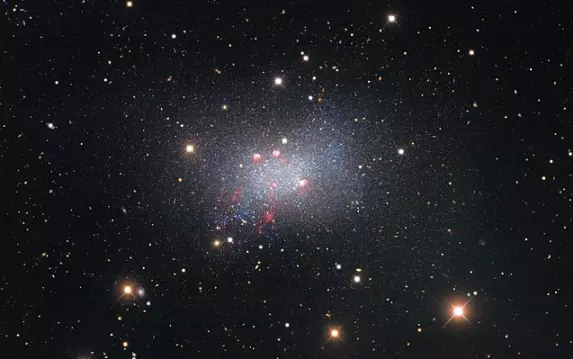
Sextans B is an irregular dwarf galaxy, meaning that it is irregularly shaped and smaller than our galaxy, the Milky Way. It lies around 4.5 million light-years from Earth and is located in the constellation Sextans in the southern sky. Captured with the Nicholas U. Mayall 4-meter Telescope, this image of Sextans B features red-colored star-forming regions near the galaxy’s center. Surrounding the galaxy are several bright stars that are located much closer to us in our galaxy, identified by the crisscross patterns created by light interacting with the structure of the telescope, as well as numerous fuzzy-looking background galaxies that appear small because they are much farther away than Sextans B. Image: KPNO/NOIRLab/NSF/AURA Data obtained and processed by: P. Massey (Lowell Obs.), G. Jacoby, K. Olsen, & C. Smith (AURA/NSF); image processing: T.A. Rector (University of Alaska Anchorage/NSF’s NOIRLab), M. Zamani (NSF’s NOIRLab) & D. de Martin (NSF’s NOIRLab)
Sextans I
The Sextans Dwarf Spheroidal galaxy, also known as Sextans I, lies at a distance of only 290,000 light years from the Sun and is one of the satellites of our own galaxy, the Milky Way. The galaxy is receding from us at 224 km/s.
Sextans I has an apparent magnitude of 10.4. It was discovered in 1990 by Michael Irwin, director of the Cambridge Astronomical Survey Unit and one of the discoverers of the Sagittarius Dwarf Elliptical Galaxy and the Cetus Dwarf.
UGC 5797
UGC 5797 is an emission line galaxy, one currently undergoing active star formation. It lies at a distance of 34 million light years and has an apparent magnitude of 14.4.
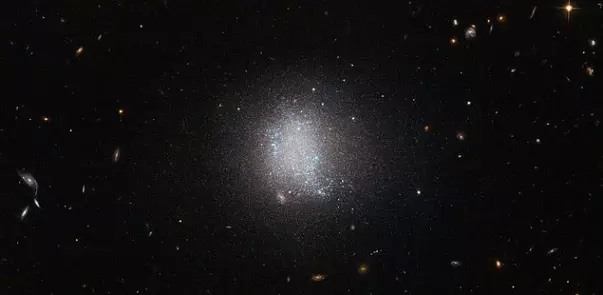
The smudge of stars at the centre of this NASA/ESA Hubble Space Telescope image is a galaxy known as UGC 5797. UGC 5797 is an emission line galaxy, meaning that it is currently undergoing active star formation. The result is a stellar population that is constantly being refurbished as massive bright blue stars form. Galaxies with prolific star formation are not only veiled in a blue tint, but are key to the continuation of a stellar cycle. In this image UGC 5797 appears in front of a background of spiral galaxies. Spiral galaxies have copious amounts of dust and gas — the main ingredient for stars — and therefore often also belong to the class of emission line galaxies. Spiral galaxies have disc-like shapes that drastically vary in appearance depending on the angle at which they are observed. The collection of spiral galaxies in this frame exhibits this attribute acutely: Some are viewed face-on, revealing the structure of the spiral arms, while the two in the bottom left are seen edge-on, appearing as plain streaks in the sky. There are many spiral galaxies, with varying colours and at different angles sprinkled across this image — just take a look. A version of this image was entered into the Hubble’s Hidden Treasures image processing competition by Luca Limatola. Image: ESA/Hubble & NASA. Acknowledgement: Luca Limatola
CL J1001+0220
CL J1001+0220 is the most distant known galaxy cluster as of 2016. It is located at a distance of 11.1 billion light years from Earth.
CL J1001+0220 is also the first cluster observed in the stage of evolving from a proto-cluster to a mature cluster. It contains 17 galaxies. Nine of the eleven massive galaxies in the cluster’s central region are showing evidence of new stars forming at a very high rate.
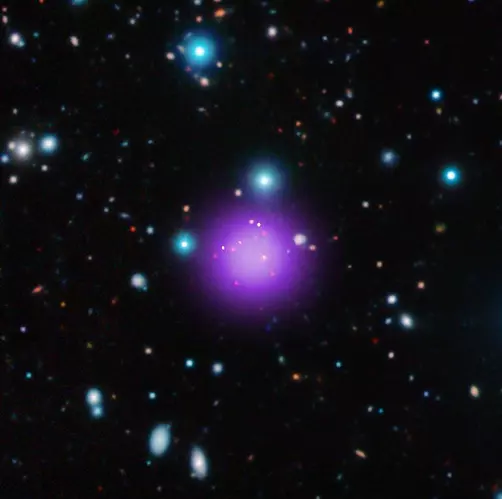
The galaxy cluster CL J1001+0220 is the most distant galaxy cluster ever discovered and may have been caught right after birth, a brief, but important stage of cluster evolution never seen before. This composite shows CL J1001+0220 in X-rays from Chandra (purple), infrared data from the UltraVISTA telescope (red, green, and blue), and radio waves from ALMA (green). The discovery of this object pushes back the formation time of galaxy clusters – the largest structures in the Universe held together by gravity – by about 700 million years. Image – X-ray: NASA/CXC/Université Paris/T.Wang et al; Infrared: ESO/UltraVISTA; Radio: ESO/NAOJ/NRAO/ALMA
Cosmos Redshift 7
Cosmos Redshift 7 (CR7) is one of the oldest, most distant galaxies known. It is a high-redshift Lyman-alpha emitter galaxy located about 12.9 billion light years from the solar system. The galaxy contains Population III (first generation) stars, formed during the reionization epoch, when the Universe was only 800 million years old, not long after the Big Bang.
Lyman-alpha emitters are typically young, exceptionally distant, low-mass galaxies that have the highest specific star formation rate of any galaxies known. They provide clues into the history of the Universe and are believed to be the progenitors of modern Milky Way-type galaxies.
Cosmos Redshift 7 also contains old, metal-poor Population II stars and is three times brighter than other exceptionally distant galaxies. The galaxy’s nickname was inspired by the Portuguese footballer Cristiano Ronaldo, who is known as CR7.
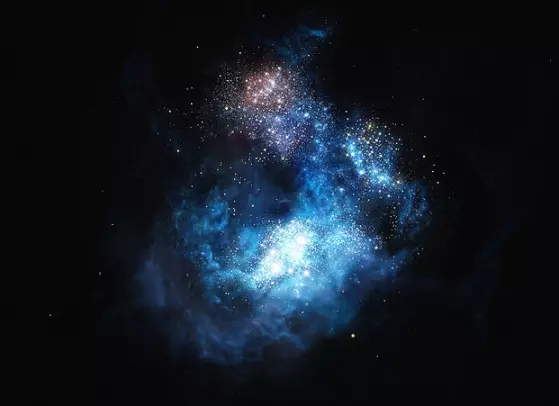
This artist’s impression shows CR7 a very distant galaxy discovered using ESO’s Very Large Telescope. It is by far the brightest galaxy yet found in the early Universe and there is strong evidence that examples of the first generation of stars lurk within it. These massive, brilliant, and previously purely theoretical objects were the creators of the first heavy elements in history — the elements necessary to forge the stars around us today, the planets that orbit them, and life as we know it. This newly found galaxy is three times brighter than the brightest distant galaxy known up to now. Image: ESO/M. Kornmesser
CID-42
CID-42 (also catalogued as CXOC J100043.1+020637), is a galaxy quasar located at an approximate distance of 3.9 billion light years. The object is believed to contain a supermassive black hole at its core and be the result of a collision between two smaller galaxies. It has an extended trail of stars.
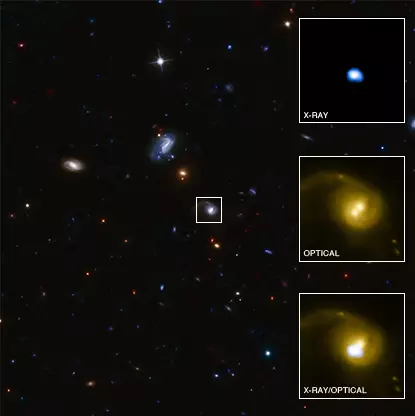
X-ray and optical images of the galaxy CID-42 showing the bright X-ray spot which may be a black hole. Image – X-ray: NASA/CXC/SAO/F.Civano et al; Optical: NASA/STScI; Optical (wide field): CFHT, NASA/STScI
When the two smaller galaxies collided, their black holes also collided to form a single supermassive black hole, which then recoiled from the gravitational waves produced by the collision and is now being ejected from the galaxy. Once it is ejected, the black hole will likely shine as a displaced quasar until it exhausts its fuel, which could take anywhere from 10 million to 10 billion years.
Sextans is the location of the field studied by the Cosmic Evolution Survey (COSMOS) project, undertaken by the Hubble Space Telescope to survey a 2-square degree equatorial field in the constellation with the Advanced Camera for Surveys (ACS). More than 2 million galaxies were detected during the survey, spanning 75% of the age of the Universe.
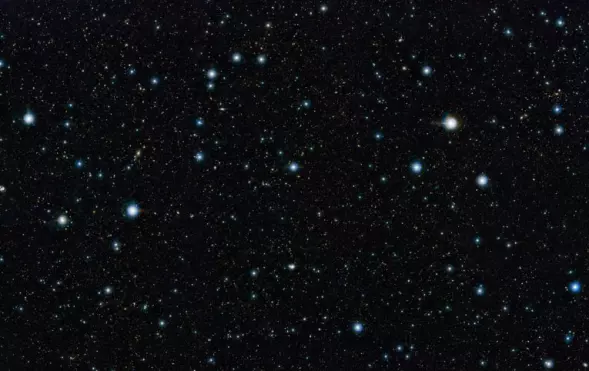
This view shows a section of the widest deep view of the sky ever taken using infrared light, with a total effective exposure time of 55 hours. It was created by combining more than 6000 individual images from the VISTA survey telescope at ESO’s Paranal Observatory in Chile. This picture shows a region of the sky known as the COSMOS field in the constellation of Sextans (The Sextant). More than 200 000 galaxies have been identified in this picture. Image: ESO/UltraVISTA team. Acknowledgement: TERAPIX/CNRS/INSU/CASU